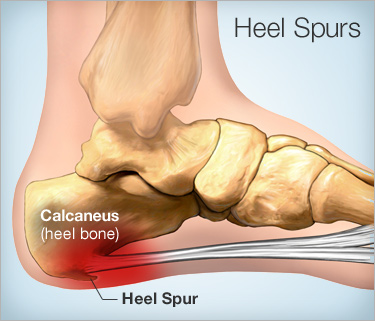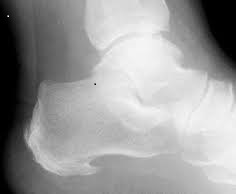
Heel Spurs
Posted By irvinechiro / Date Posted: 2016-02-25
|
|
|
What is a Heel Spur? Chances are if you have an xray that looks like this you already know what a heel spur is, but if you don't this is what one looks like.
Heel spurs are a common source of
heel pain. Heel spurs are a bony growth attached to your heel bone
(calcaneus) and grow into your foot arch. What Causes a Heel Spur? A heel spur is generally caused by a long standing case of plantar fasciitis, a tightening and inflammation of the tissue underneath the foot. Your plantar fascia is a thick fibrous band of connective tissue originating on the bottom surface of the calcaneus (heel bone) and extending along the sole of the foot towards the toes. Your plantar fascia acts as a passive limitation to the over-flattening of you arch. When your plantar fascia develops micro tears or becomes inflamed it is known as plantar fasciitis. When plantar fasciitis healing is delayed or injury persists, your body repairs the weak and injured soft tissue with bone. Usually your injured fascia will be heal via the activity of specialized cells called fibroblasts. These cells work for around 6 weeks. If your injury persists beyond this time, another type of cell called an osteoblast is recruited to the area. Osteoblasts form bone and the end result is bone (or calcification) within the plantar fascia or at the calcaneal insertion. These bone formations are known as heel spurs. This scenario is most common in the traction type injury. The additional bone growth is known as a heel spur or calcaneal spur. What are the Symptoms of a Heel Spur? - You'll typically first notice early heel spur pain under your heel in the morning or after resting. - Your heel pain will be worse with the first steps and improves with activity as it warms up. - When you palpate the tender area you may feel a tender bony lump. How Does a Heel Spur Progress? As your plantar fasciitis deteriorates and your heel spur grows, the pain will be present more often. How is a Heel Spur Diagnosed? Heel spurs and plantar fasciitis is usually diagnosed based on your symptoms, history and clinical examination. After confirming your heel spur or plantar fasciitis they will investigate WHY you are likely to be predisposed to heel spurs and develop a treatment plan to decrease your chance of future bouts. X-rays will show calcification or bone within the plantar fascia or at its insertion into the calcaneus. This is known as a calcaneal spur or heel spur. Ultrasound scans and MRI are used to identify any plantar fasciitis tears, inflammation or calcification. Risk Factors for Heel Spurs You are more likely to develop plantar fasciitis and heel spurs if you are: Active - Sports that place excessive stress on the heel bone and attached tissue, especially if you have tight calf muscles or a stiff ankle from a previous ankle sprain, which limits ankle movement eg. running, ballet dancing and aerobics. Overweight - Carrying around extra weight increases the strain and stress on your plantar fascia. On your feet – Having a job that requires a lot of walking or standing on hard surfaces ie factory workers, teachers and waitresses. Flat Feet or High Foot Arches – Changes in the arch of your foot changes the shock absorption ability and can stretch and strain the plantar fascia, which then has to absorb the additional force. Middle-Aged or Older – With ageing the arch of your foot may begin to sag – putting extra stress on the plantar fascia. Wearing shoes with poor support. Weak Foot Arch Muscles. Muscle fatigue allows your plantar fascia to overstress and cause injury. Arthritis. Some types of arthritis can cause inflammation in the tendons in the bottom of your foot, which may lead to plantar fasciitis. Heel Spur Prognosis The good news is that heel spur pain is rarely permanent. Plantar fasciitis, the main cause of a heel spur, is reversible and very successfully treated. Over 90 percent of people with plantar fasciitis or heel spurs improve significantly with treatment. While you may continue to see a heel spur on Xray, once you settle the inflammation adjacent to your heel spur, the heel pain will resolve. If your plantar fasciitis or heel spur pain continues after a few months of conservative treatment, your doctor may inject your heel with steroidal anti-inflammatory medications (corticosteroid). Cortisone injections have been shown to have short-term benefits but they may retard your progress in the medium to long-term, which can mean that you will suffer recurrent bouts for longer. Further research is required to improve results. Heel Spur Treatment Due to poor foot biomechanics being the primary cause of your plantar fasciitis it is vital to thoroughly assess and correct your foot and leg biomechanics to prevent future plantar fasciitis episodes or the development of a heel spur. Your chiropractor is an expert in foot assessment and its dynamic biomechanical correction. They may recommend that you seek the advice of a podiatrist, who is an expert in the prescription on passive foot devices such as orthotics. Active foot stabilisation exercises are an excellent long-term solution to prevent and control heel spurs and plantar fasciitis. Researchers have concluded that there are essentially 8 stages that need to be covered to effectively rehabilitate plantar fasciitis and prevent recurrence. These are: 1. Early Injury Protection: Pain Relief & Anti-inflammatory Modalites 2. Regain Full Range of Motion 3. Restore Foot Arch Muscle Control 4. Restore Normal Calf & Leg Muscle Control 5. Restore Normal Foot Biomechanics 6. Improve Your Running and Landing Technique 7. Return to Sport or Work 8. Footwear Analysis Treatment of heel spurs is similar to plantar fasciitis treatment. Your chiropractor will select the most appropriate treatment modalities for you. Ultimately, biomechanical correction is the aim. Foot intrinsic muscle strengthening (including tibialis posterior and peroneus longus) and calf strengthening is almost always required, however in some instances stretching can actually do more harm than good. Mechanical treatment that involves taping and orthoses has been shown to be more effective than either anti-inflammatories or accommodative modalities. What Happens If You Do Nothing? Left untreated, heel spurs grow larger and usually become excessively painful. For more specific advice about your heel spur or plantar fasciitis, please contact us on 96305517. |
Tweet






